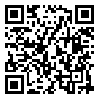دوره 17، شماره 4 - ( 9-1398 )
جلد 17 شماره 4 صفحات 350-341 |
برگشت به فهرست نسخه ها
Download citation:
BibTeX | RIS | EndNote | Medlars | ProCite | Reference Manager | RefWorks
Send citation to:



BibTeX | RIS | EndNote | Medlars | ProCite | Reference Manager | RefWorks
Send citation to:
Mirzaie H, Hassani Mehraban A, Hosseini S A, Ghasemi Fard F, Jafari Oori M. Comparison of the Effect of Filial and Adlerian Play Therapy on Attention and Hyperactivity of Children With Attention Deficit Hyperactivity Disorder: A Randomized Clinical Trial. Iranian Rehabilitation Journal 2019; 17 (4) :341-350
URL: http://irj.uswr.ac.ir/article-1-997-fa.html
URL: http://irj.uswr.ac.ir/article-1-997-fa.html
Comparison of the Effect of Filial and Adlerian Play Therapy on Attention and Hyperactivity of Children With Attention Deficit Hyperactivity Disorder: A Randomized Clinical Trial. مجله انگلیسی زبان توانبخشی. 1398; 17 (4) :341-350
چکیده: (8115 مشاهده)
Objectives: For children with Attention Deficit Hyperactivity Disorder (ADHD), different types of play therapy may have different effects. This study aimed to compare the effect of two play therapy intervention methods including a child-parents therapy named as Filial Therapy (FT) and a child therapist therapy known as Adlerian Therapy (AT) on attention and hyperactivity of these children.
Methods: In this randomized clinical trial which lasted from February 20 to May 5 of 2014, 51 boys and girls aged 6-12 years with ADHD were selected and allocated randomly by blocked blocks to three groups of 17 subjects in each one. From three groups, two ones received FT and AT intervention and one group remained as a control group. Participation’s parents in the FT group received one session training play therapy per week for 10 weeks and played with their children at home every day during this time. The AT group acquired three sessions play therapy for 10 weeks in the clinics. Attention and hyperactivity of the subjects were gathered in pre and post-test and three months after that as a fallow-up time by Child Symptom Inventory-4 (CSI-4) and Test of Everyday Attention for Children (TEA-Ch). The Mean, standard deviation and frequency were used as descriptive statistics and the Chi-squared, one-way ANOVA, Man-Whitney, Kruskal-Wallis tests, and Generalized Estimating Equation (GEE) were utilized as analytical statistics in the SPSS version of 22. The alpha of 0.05 considered as the significant level.
Results: 50 percent of the subjects were male and the mean ± SD of the age of the subjects were 8±2 years old. The mean ± SD of hyperactivity in the FT group were 23.94 ± 13.44, 20.82 ± 11.64, and 20.76±11.13, in the AT group were 17.70 ± 3.70, 15.20 ± 3.33 and 15±3.50, and in the control group were 24.25 ± 10.32, 25.38 ± 11.48 and 24.81±11.96, respectively. The mean ± SD of attention in the FT group were 8.47 ± 5.33, 15.60 ± 2.79 and 15.80±2.50, in the AT group were 6.71± 5.31, 12.24± 3.33 and 12.90±3.12, and in control group were 9.71± 5.36, 10.41± 3.24 and 9.92±4.89, respectively. As the result showed, hyperactivity of the subjects had significantly decreased in the intervention groups (p <0.05) compared with the control group. Also, the attention of the subjects had significantly increased in the intervention groups (p <0.05) compared with the control ones.
Discussion: Although both methods reduced the severity of hyperactivity and increased the attentional performance of the subjects, but the effectiveness of FT method was more enormous. The founding indicated that participating of parents in the treatment process could exceed the rehabilitation procedure of children with ADHD.
Methods: In this randomized clinical trial which lasted from February 20 to May 5 of 2014, 51 boys and girls aged 6-12 years with ADHD were selected and allocated randomly by blocked blocks to three groups of 17 subjects in each one. From three groups, two ones received FT and AT intervention and one group remained as a control group. Participation’s parents in the FT group received one session training play therapy per week for 10 weeks and played with their children at home every day during this time. The AT group acquired three sessions play therapy for 10 weeks in the clinics. Attention and hyperactivity of the subjects were gathered in pre and post-test and three months after that as a fallow-up time by Child Symptom Inventory-4 (CSI-4) and Test of Everyday Attention for Children (TEA-Ch). The Mean, standard deviation and frequency were used as descriptive statistics and the Chi-squared, one-way ANOVA, Man-Whitney, Kruskal-Wallis tests, and Generalized Estimating Equation (GEE) were utilized as analytical statistics in the SPSS version of 22. The alpha of 0.05 considered as the significant level.
Results: 50 percent of the subjects were male and the mean ± SD of the age of the subjects were 8±2 years old. The mean ± SD of hyperactivity in the FT group were 23.94 ± 13.44, 20.82 ± 11.64, and 20.76±11.13, in the AT group were 17.70 ± 3.70, 15.20 ± 3.33 and 15±3.50, and in the control group were 24.25 ± 10.32, 25.38 ± 11.48 and 24.81±11.96, respectively. The mean ± SD of attention in the FT group were 8.47 ± 5.33, 15.60 ± 2.79 and 15.80±2.50, in the AT group were 6.71± 5.31, 12.24± 3.33 and 12.90±3.12, and in control group were 9.71± 5.36, 10.41± 3.24 and 9.92±4.89, respectively. As the result showed, hyperactivity of the subjects had significantly decreased in the intervention groups (p <0.05) compared with the control group. Also, the attention of the subjects had significantly increased in the intervention groups (p <0.05) compared with the control ones.
Discussion: Although both methods reduced the severity of hyperactivity and increased the attentional performance of the subjects, but the effectiveness of FT method was more enormous. The founding indicated that participating of parents in the treatment process could exceed the rehabilitation procedure of children with ADHD.
نوع مقاله: پژوهشي |
موضوع مقاله:
کاردرمانی
دریافت: 1397/11/17 | پذیرش: 1398/4/30 | انتشار: 1398/10/8
دریافت: 1397/11/17 | پذیرش: 1398/4/30 | انتشار: 1398/10/8





